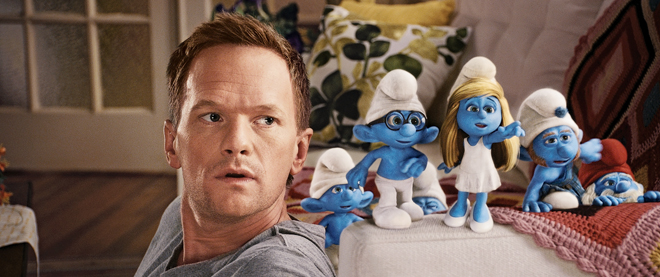Don’t you dare smurf at the Smurfs
The highly bankable little blue characters star in their own movie
Courtesy of Sony Pictures Animation; Everett Collection
Share

The Smurfs have done what Tintin and other European comic strip characters never could. They’ve conquered North America. The Smurfs movie comes out July 29, and since it has famous blue characters saying things like “you smurfed with the wrong girl,” nobody’s expecting it to get good reviews. But the studio, Sony, does expect it to make some money: Smurfs have been bankable here since 1980, when the Belgian comics were adapted into a TV cartoon. Other French-language comics have trouble crossing the sea. The producer of Steven Spielberg’s upcoming Tintin, also based on a Belgian comic, admitted to the press that it’s a risk because Tintin “is known so well in Europe and virtually not at all here.” But veteran TV screenwriter Marc Zicree told Maclean’s that when he told a young American about writing for the Smurfs cartoon in the ’80s, “I was like Moses coming down off the mountain.”
It’s easy to see that the Smurfs, created (as Les Schtroumpfs) in 1958, have become part of North American culture in a way that, say, Asterix can’t match. On June 25, for the anniversary of the birth of Smurfs creator Peyo, Sony sponsored “Global Smurfs Day,” a worldwide gathering of people who painted their faces blue and wore white hats just like his creations. There have been Smurfs parodies on shows like Family Guy, Robot Chicken and Saturday Night Live; North American college students used to have a drinking game where they took a drink every time a character in the show said “Smurf” in place of a normal word. Eric Leroy, who is curating an exhibition devoted to Peyo and the Smurfs at the Arcurial gallery in Paris, told Maclean’s “the children of the world identify with the Smurfs.”
This worldwide popularity is mostly thanks to the cartoon, still in reruns on channels like Teletoon Retro. Though some of the shows were adaptations of Peyo stories, Zicree says the writers started to “bring an American boisterousness” to the franchise, creating new stories with a non-European slant: “I was a big science fiction geek,” he recalls, “so I wrote one about an alien who visits the Smurf village and impersonates a Smurf.” That North American take on the Smurfs has come to define them even on Peyo’s home turf. “In Europe,” Leroy explains, “the comics are popular—25 million copies—but the TV show is more popular today.”
It may also help that the Smurfs are among the most merchandisable beings in the world. Though they have been spinning off products ever since they were created—Zicree says that when he was hired to write for the cartoon, what he mostly knew of the franchise was “the little blue figurines” in antique shops—the U.S. and Canada soon surpassed the rest of the world in buying Smurfs toys. Nearly all Smurfs look alike, so they’re easy to manufacture, yet they all have different personalities: Brainy Smurf is the smart one who gets beaten up by his dumb friends, and Vanity Smurf, Zicree says, was often “assumed to be gay, whether or not he was.” Zicree thinks these diverse characters sent “a positive message” to children by showing that “even though the Smurfs all looked the same, they didn’t need to be the same.” But it also means that if a Smurfs film catches on, it could spin off as many products as Cars.
North America may have embraced the Smurfs as their own, but their European-ness may have helped them become popular, too. Zicree says that one of the reasons the cartoon made an impact is that Peyo’s story of a hidden village “was sort of a new thing upon the scene. It wasn’t funny animals and it wasn’t superheroes. It was kind of like magical adventure with humour.” French sociologist Antoine Buéno recently published The Little Blue Book, in which he argues that the Smurf Village is a microcosm of European socialism and fascism, calling the group an “archetype of a totalitarian utopia” and comparing Papa Smurf to Stalin. Peyo might have thought this was going too far, but Zicree says that when asked why there was only one female Smurf, Peyo replied, “Smurfette is your mother, she is your sister, she is all women.” In America, it seems, we’re happy to accept European collectivist cartoons, as long as they’re cute.
The next big (little) thing?
Which ’80s cartoon will be next to get a big movie? We’re betting on the Snorks. Merchandising tie-ins? Who wouldn’t want a doll with a retractable snorkel head? Off-colour jokes? The “blowhole” lines write themselves. Popular villains? Count Snorkula is begging for a comeback.